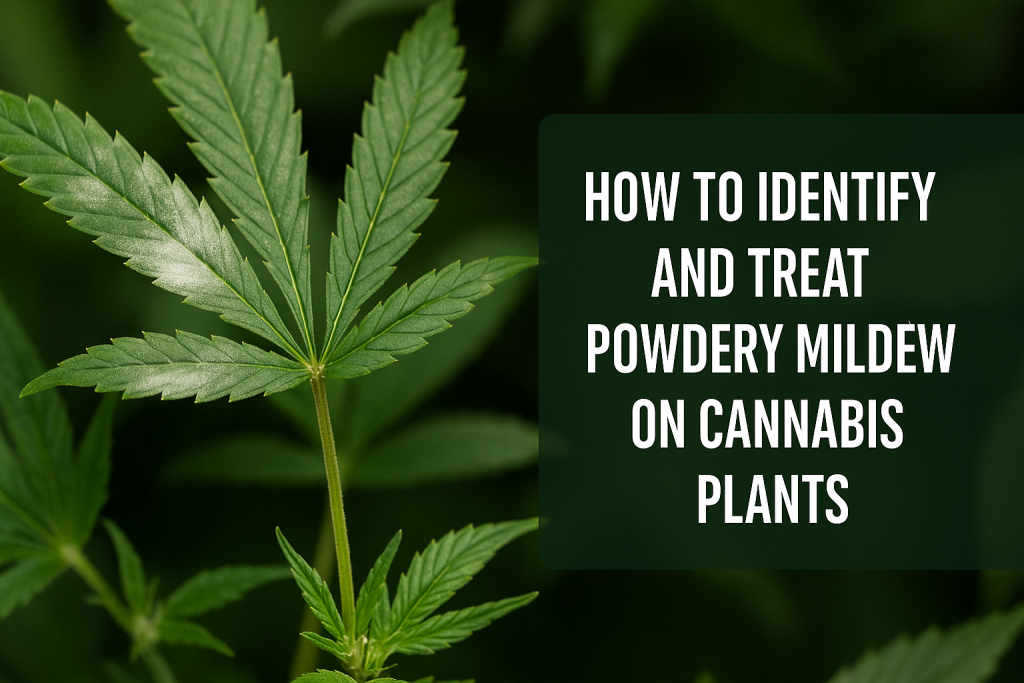How to identify and treat powdery mildew on cannabis plants?

Powdery mildew is one of the most common fungal diseases that cannabis growers face. It spreads quickly, thrives in enclosed grow environments, and can devastate yields if not addressed promptly and properly. Fortunately, with proper identification and proactive treatment, growers can keep this pathogen under control and protect their plants.
What Is Powdery Mildew?
Powdery mildew is a fungal disease caused by a variety of closely related species in the Erysiphales order. On cannabis plants, it typically appears as a white or gray powdery coating on leaves, stems, and sometimes buds.
Unlike many other fungal diseases though, powdery mildew doesn’t need standing water to germinate. Instead, it thrives in warm, humid environments with poor airflow – conditions common in indoor and greenhouse grows.
How to Identify Powdery Mildew
In order to protect your plants, early detection is critical. The sooner you spot powdery mildew, the easier it is to manage.
Signs include:
- White patches: Circular or irregular spots that look like flour dusted on leaves.
- Leaf curling or distortion: Infected leaves may twist or curl as the fungus spreads.
- Reduced photosynthesis: Leaves covered in mildew lose their ability to capture light efficiently.
- Bud contamination: In advanced cases, powdery mildew infiltrates buds, rendering them unsmokable.
A good rule of thumb is, if you see anything resembling talcum powder on your cannabis leaves, assume it’s powdery mildew.
Why Powdery Mildew Is a Serious Threat
- Rapid spread: Spores can travel via air, water, tools, or even clothing.
- Dormancy: Spores can remain inactive on surfaces, waiting for favorable conditions.
- Yield and quality loss: Severe infections can choke photosynthesis, stunt growth, and ruin flowers.
- Health risks: Smoking mildew-contaminated buds can irritate the lungs and pose health hazards.
How to Treat Powdery Mildew
Once identified, immediate action is required. Here are some common and most recommended treatment options.
1. Environmental Control
- Lower humidity to 40-50%.
- Increase air circulation with oscillating fans.
- Maintain daytime temps of 75-80°F and avoid cold nighttime dips that create condensation.
2. Pruning and Removal
- Remove and dispose of heavily infected leaves (do not compost).
- Thin out dense canopies to improve airflow.
3. Natural Sprays
- Neem oil: An organic antifungal and insecticidal oil that can suppress outbreaks.
- Potassium bicarbonate: Raises leaf surface pH, killing spores on contact.
- Sulfur sprays: Effective but must be used cautiously and never during flowering, as they can alter bud taste.
4. Biological Controls
- Beneficial microbes such as Bacillus subtilis or Trichoderma species can outcompete powdery mildew fungi.
How to Prevent Powdery Mildew
Prevention is always better than treatment. Here are the best practices you should implement.
- Proper spacing: Don’t overcrowd plants – give them room to breathe.
- Canopy management: Use pruning and training methods (like LST or SCROG) to improve light penetration and airflow.
- Regular monitoring: Inspect plants daily for early signs.
- Cleanliness: Sterilize tools and equipment regularly. Wash hands before working in your grow.
- Strain selection: Consider mold-resistant cultivars when growing in humid climates.
Final Thoughts
Powdery mildew is every cannabis grower’s enemy, but it doesn’t have to spell disaster. By learning to identify its early signs, implementing strong environmental controls, and using targeted treatments, you can keep this fungus from overtaking your crop.
The best strategy combines prevention with vigilance. Growers who monitor closely and act quickly are far less likely to lose yield or quality to this stubborn disease.